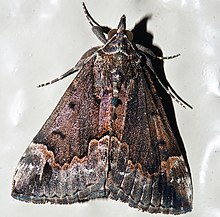Hypena baltimoralis, the Baltimore bomolocha or Baltimore hypena, is a moth of the family Erebidae. The species was first described by Achille Guenée in 1854. The moth flies from April to October depending on the location. There are at least two generations in New England and additional generations southward.
| Hypena baltimoralis | |
|---|---|

| |
| Scientific classification | |
| Domain: | Eukaryota |
| Kingdom: | Animalia |
| Phylum: | Arthropoda |
| Class: | Insecta |
| Order: | Lepidoptera |
| Superfamily: | Noctuoidea |
| Family: | Erebidae |
| Genus: | Hypena |
| Species: | H. baltimoralis
|
| Binomial name | |
| Hypena baltimoralis Guenée, 1854
| |
| Synonyms | |
| |

Description edit
Adults have a wingspan of 26–32 mm (1.0–1.3 in) and rest with their hindwings tucked behind their forewings, giving them a triangular silhouette. The forewings are grayish-brown and females may have a lighter tint often absent in males. They have a large dark patch covering much of the outer sides of the forewings which extends to about 3/4ths of the length of the wings but does not expand to touch the inner margin. The inner margins and lower areas of the wings are bottled greyish-brown with a dark brown or black diagonal line extending inward from each corner. This is more visible in females.[1][2]
Range and Habitat edit
It is found in the eastern part of the United States, west and south to Wisconsin, Missouri and Florida and Texas. They are most commonly sighted in or near deciduous forests.[3][4]
Ecology edit
The larvae feed on maple, mainly red and silver maple.
References edit
- ^ "Species Hypena baltimoralis - Baltimore Hypena - Hodges#8442". bugguide.net. Retrieved 2024-01-07.
- ^ "Baltimore Snout". www.insectidentification.org. Retrieved 2024-01-07.
- ^ "Species Hypena baltimoralis - Baltimore Hypena - Hodges#8442". bugguide.net. Retrieved 2024-01-07.
- ^ "NatureServe Explorer 2.0". explorer.natureserve.org. Retrieved 2024-01-07.
- Wagner, David L.; Schweitzer, Dale F.; Sullivan, J. Bolling & Reardon, Richard C. (2011). Owlet Caterpillars of Eastern North America. Princeton University Press. ISBN 978-0691150420.
- Bartlett, Troy (September 19, 2018). "Species Hypena baltimoralis - Baltimore Hypena - Hodges#8442". BugGuide. Retrieved February 12, 2020.